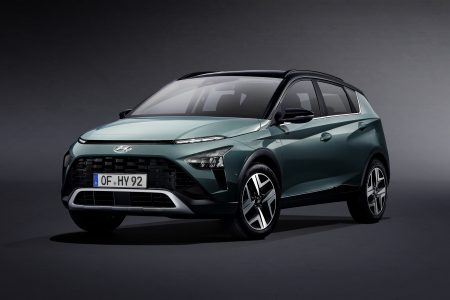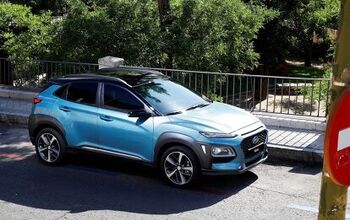Hyundai Releases Bayon Euro Crossover
Don’t get too excited. Hyundai’s Bayon is at present a European-only crossover SUV that the brand announced today. All-new in the B-segment, Bayon is named after Bayonne, a sought-after vacation destination in the south of France.
The growing popularity of SUVs in Europe was the reason for Hyundai’s introduction, and the forward-motion stance of the Bayon is in keeping with the design characteristics of the segment. Bayon is the seventh new or enhanced model Hyundai has released in the past year.
What’s most interesting about the Bayon isn’t the styling or its cargo capacity, but the array of powertrains. Topping the roster is a 1.0-liter or 61 cubic-inch, 118-horsepower T-GDi turbocharged engine. Paired with Hyundai’s 48-volt mild-hybrid technology, it can be backed by a six-speed intelligent manual transmission (iMT), or a seven-speed dual-clutch transmission (7DCT). A 98-HP variant of the 1.0-liter is offered without 48V, with a choice of either a 6-speed manual transmission or the 7DCT. There’s also a 1.2-liter, 82-HP MPi engine backed by a 5-speed manual, the fifth variation in Bayon’s powertrain matrix. Too confusing to offer this many powertrain choices here in the U.S.?
The Hyundai SUV with the first application of Rev Matching, it provides smoother downshifts due to engine-output shaft synchronization. This attribute was previously limited to the company’s performance models. Available with the 1.0-liter T-GDi engine when mated with the 7DCT in any drive mode, and the same engine with 48V when the 6iMT transmission is chosen.
In mentioning cargo capacity, the Bayon offers 411-liters or about 14.5-cubic feet of space for everything you might need to carry. Hyundai thoughtfully provides a sliding trunk cover to keep your own possessions stored within. A little over 13.5-feet long, 5.82-feet wide, and 4.88-feet tall, the Bayon is stretched over an 8.46-foot wheelbase, with what Hyundai Motor Europe deems adequate with slightly less than three feet of legroom.
Available in nine exterior colors, mangrove green pearl is the launch color, along with polar white, silver metallic, brass metallic, red pearl, turquoise metallic, blue pearl, black pearl, and grey pearl.
Is it just us, or is every vehicle being defined by its angularity? Hyundai’s coined the phrase, ‘sensuous sportiness’ to define the Bayon’s nose-forward attitude, further accentuated by its squinty, arrow-shaped headlights. Outback, the taillights form an arrow when lit, no doubt connecting the pointer shapes running throughout the crossover’s exterior design. Standard 15-inch steel wheels have been abandoned here with the exception of small trucks and entry-level vehicles. 16- and 17-inch alloy wheels are more in keeping with the upmarket intent of this B-segment player.
Inside the cockpit, there’s either 8-inch display audio with Apple CarPlay or Android Auto or a 10.25-inch audio-video navigation (AVN) unit to choose from. Two front USB ports and a single rear port allow three devices to charge all at once. One of the forward ports doubles as a data point, allowing you to connect your phone to the infotainment system. Bose speakers have been included to enhance the listening experience of the Bayon’s driver and passengers.
There was no word as to when the Bayon will go on sale or any pricing information at the time of this announcement.
[Images: Hyundai]
With a father who owned a dealership, I literally grew up in the business. After college, I worked for GM, Nissan and Mazda, writing articles for automotive enthusiast magazines as a side gig. I discovered you could make a living selling ad space at Four Wheeler magazine, before I moved on to selling TV for the National Hot Rod Association. After that, I started Roadhouse, a marketing, advertising and PR firm dedicated to the automotive, outdoor/apparel, and entertainment industries. Through the years, I continued writing, shooting, and editing. It keep things interesting.
More by Jason R. Sakurai
Latest Car Reviews
Read moreLatest Product Reviews
Read moreRecent Comments
- MaintenanceCosts 308/311 is just the rating of the gas engine by itself. The full powertrain power rating, taking into account both power sources is 483/479. The car will do 0-60 in under five seconds. Frankly, I find the idea of that being "underpowered" bizarre.Also, "understated" has never been less fashionable within my lifetime. We are in a moment where everyone wants to make a Bold Statement with everything they do.
- 28-Cars-Later @PoskySo here's some interesting data, Manheim's Used Car index is still 28% higher than shortly before the Plandemic (155 on chart) after declining from a height of 39% (roughly 215) in January 2022, yet interest rates are now more than double on average. Maybe the White House should focus on some deflationomics instead of mucking up everything?
- Dale Had one. The only car I ever bought because of a review in a guitar magazine.Sure was roomy inside for such a small car. Super practical. Not much fun to drive even with a manual.Sent it to college with my stepson where it got sideswiped. Later he traded it in on an F-150.
- Bd2 Hyundai's designs are indeed among the most innovative and their battery technologies should allow class leading fuel consumption. Smartstream hybrids are extremely reliable.
- 28-Cars-Later So now H/K motors will last longer in between scheduled replacements. Wow, actual progress.





































Comments
Join the conversation
Maybe they can bring Peter Schreyer back...
Nice Pontiac Aztek tribute.